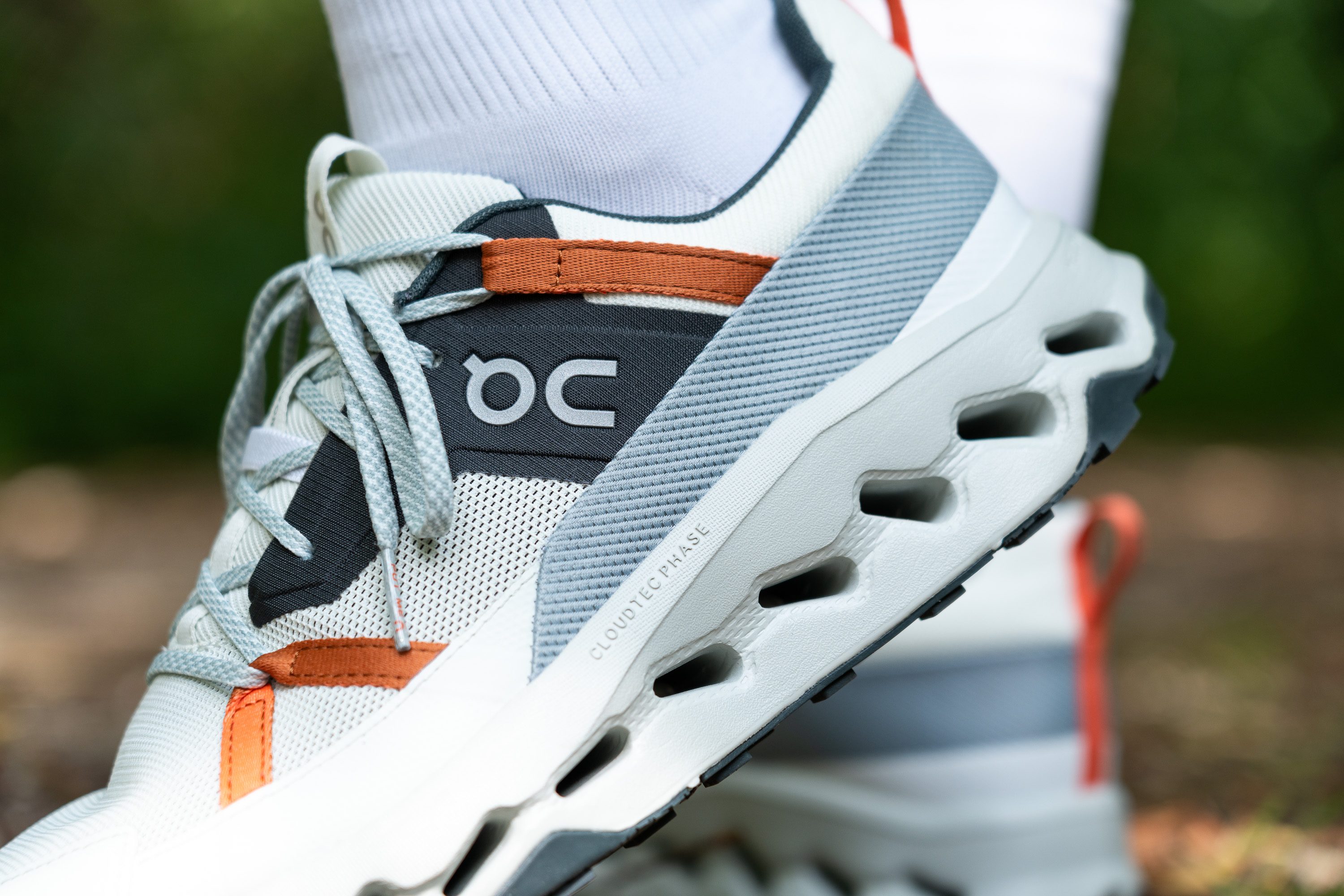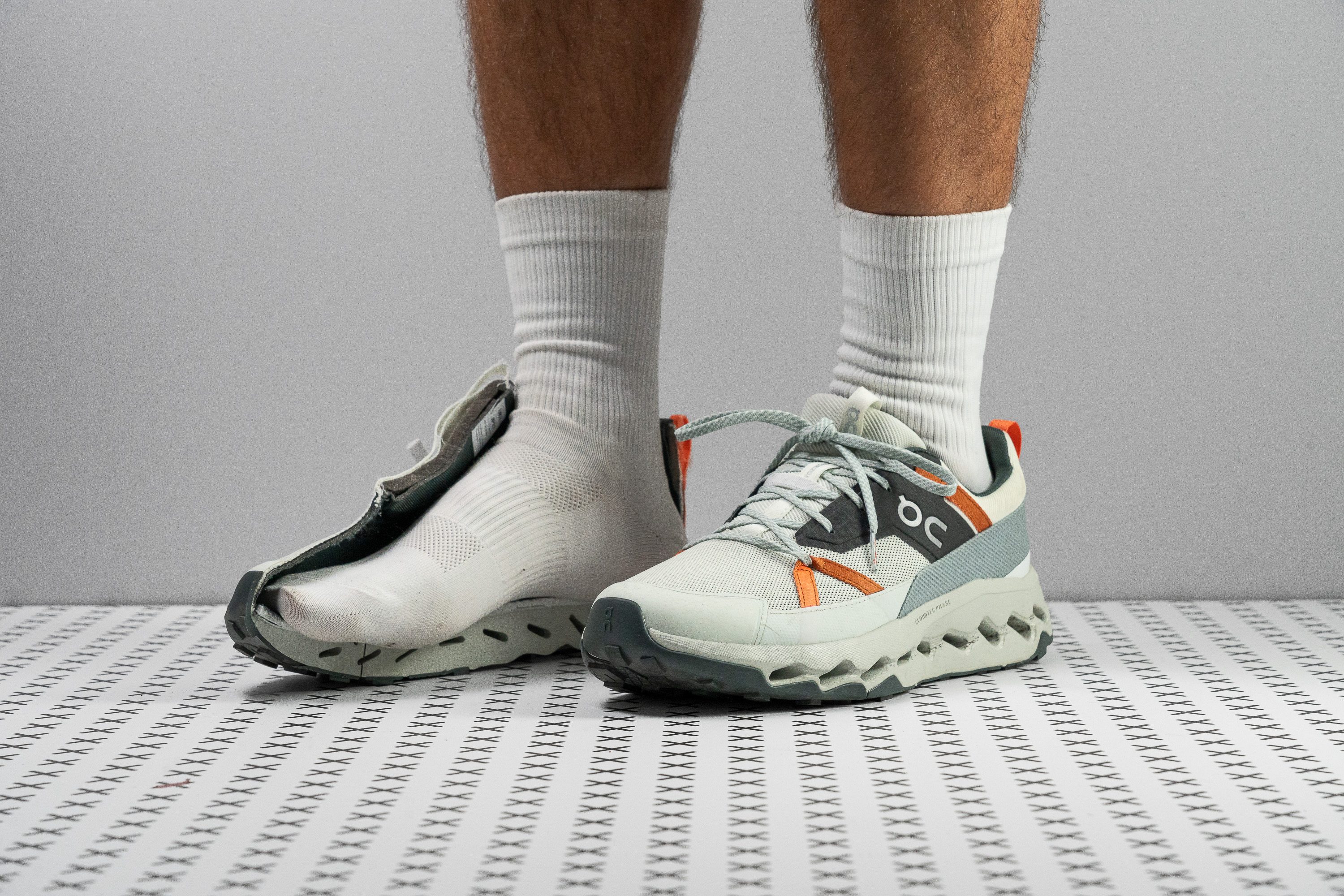Our verdict
Pros
- Toebox width at the big toe
- One of the lightest hiking shoes
- Transitions from city to trails seamlessly
- Nice and smooth heel-to-toes
- Breathable for mild weather
- Comfortable in-shoe feel
- True to size and fit
Cons
- Not a real hiking shoe
- Lacks durability for the price
- Merrell Moab Speed 2
Audience verdict
Who should buy
In our opinion, the target audience of the Cloudhorizon is rather limited. We think that you might be willing to pay the high price for this shoe if:
- mm and is only second to the
- you want a highly cushioned and fun ride that lasts all-day
- you prioritize style in outdoor footwear (even if it means less durability)
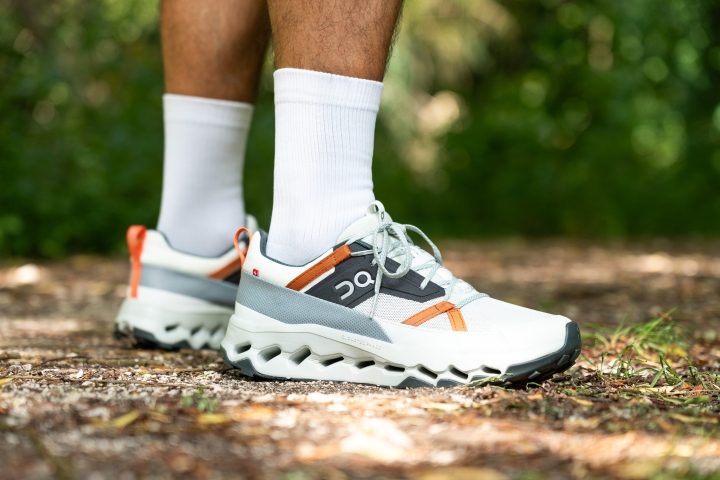
even more budget-friendly
We are convinced that you should take your money elsewhere if you are in search of a truly rugged and stable hiking shoe for all-day hikes with a heavy backpack.
Some of the non-waterproof alternatives to consider include the Flat and square, we could barely even feel them on hard city streets and the Breathable for mild weather (even more budget-friendly).
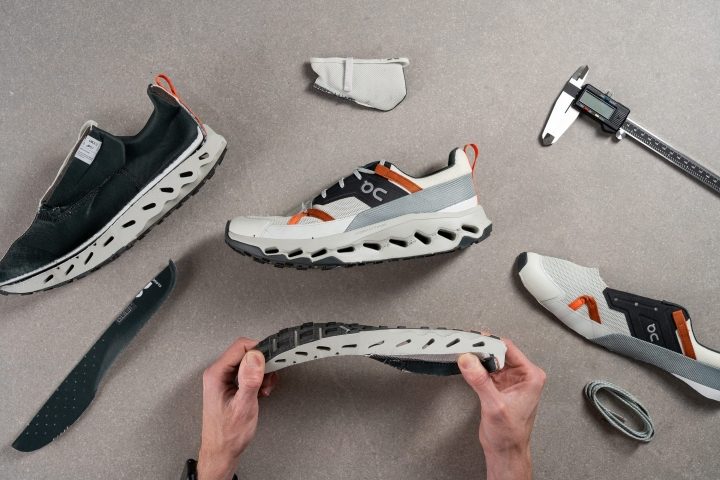
Breathability
If you are considering the Cloudhorizon for summer hikes in warm weather, we recommend thinking twice. While it’s not as toasty as most hiking shoes we’ve tested in the lab, the Cloudhorizon’s ventilation capacity is limited by the thick inner lining beneath the mesh layer.
Even the light can't shine through the padded lining inside the Cloudhorizon.
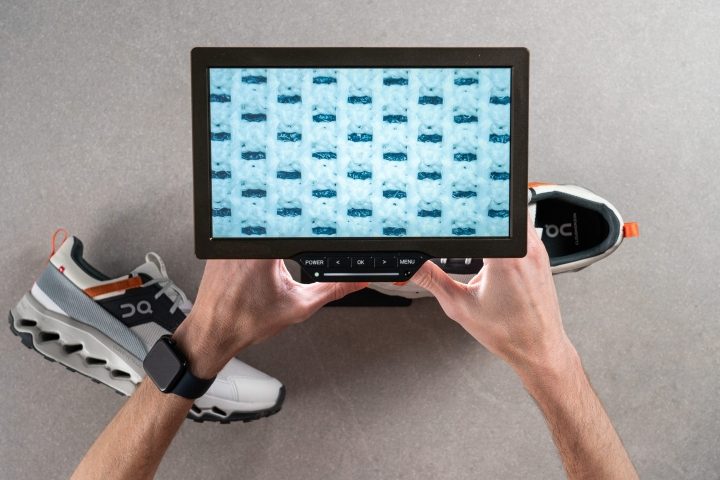
The underlayer is easier to see in our closeup microscope shot of the shoe’s upper fabric.
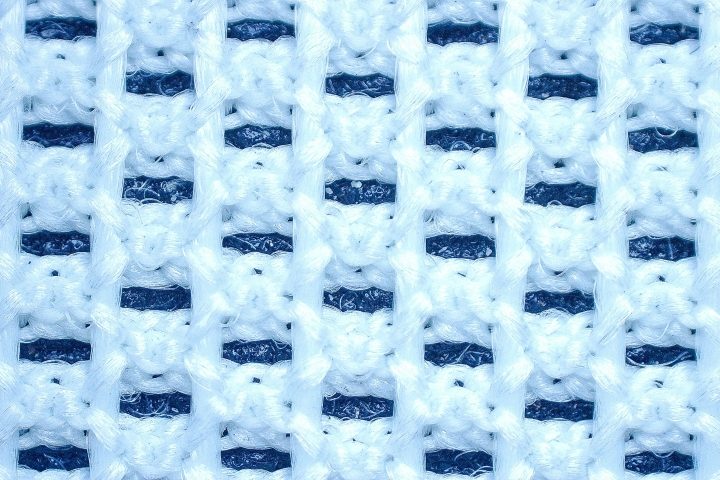
But the good news is that the inner lining doesn’t block the airflow entirely. As our smoke-pumping breathability test below shows, the shoe’s upper can channel enough air for mildly warm temperatures.
Look how effective the Cloudhorizon’s mesh cells are in the toebox area.
To sum up our meticulous breathability examination, we rated the shoe with a moderate score of 3 out of 5.
P.S. If you need a waterproof version of the Cloudhorizon instead, you can get it for $20 more ($190). It features On’s proprietary waterproofing membrane.
| Cloudhorizon | 2 |
| Average | 2.8 |
Durability
Toebox durability
Despite their hefty price tag, On Cloud shoes don’t perform well when aggressive wear and tear is involved. To our great disappointment, we found it to be true for the brand’s Cloudhorizon as well. Even though as a hiking shoe, it is supposed to be more reinforced than casual sneakers.
Our standardized Dremel test revealed that 12 seconds of drilling the shoe’s toebox with sandpaper burned a see-through hole in its mesh layer just like that. But luckily, the thicker underlayer saved the day by remaining intact.
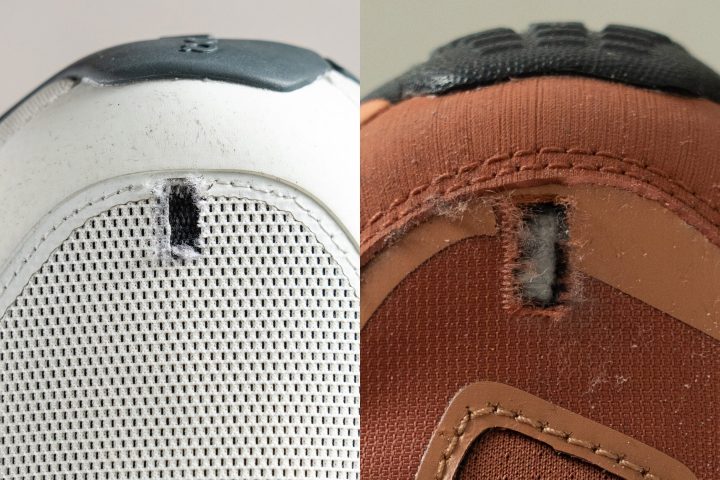
This helped to bump up the shoe’s toebox durability to 3 out of 5 as opposed to the Hoka Anacapa boot on the right. The latter scored as little as 1 out of 5 because the Dremel went through the upper completely.
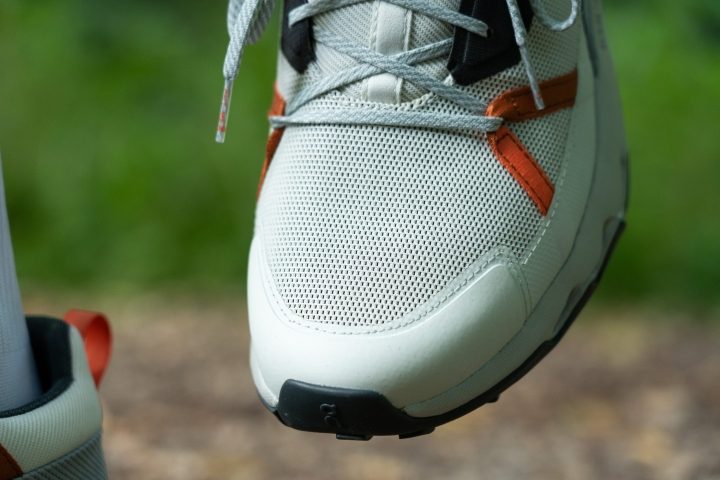
However, it doesn’t change the fact that the Cloudhorizon’s mesh upper won’t survive frequent slashes against rocks, bushes, and roots. But if you are careful enough and limit the shoe's use to light and moderate trails, its protective overlay around the forefoot should suffice.
| Cloudhorizon | 3 |
| Average | 3.8 |
Heel padding durability
Unfortunately, it wasn’t just the upper mesh of the Cloudhorizon that left us wishing for more.
The textile around the shoe’s heel counter did not show very promising wear resistance either. As little as 4 seconds of Dremel exposure left this part of the shoe completely torn.

Compared to other hiking shoes we’ve tested, the damage was major enough to lower the heel lining durability rating to only 2 out of 5. We expect some premature wear in this part of the Cloudhorizon, especially if you’re prone to developing holes in the shoe lining.
| Cloudhorizon | 2 |
| Average | 3.1 |
Outsole hardness
Checking the bottom of the Cloudhorizon, we weren’t convinced that we were looking at a proper hiking shoe, to be honest. Thin rubber layer, shallow and sparse lugs, exposed foam with undulations that attract pebbles… Not a great first impression, we’ve got to say.
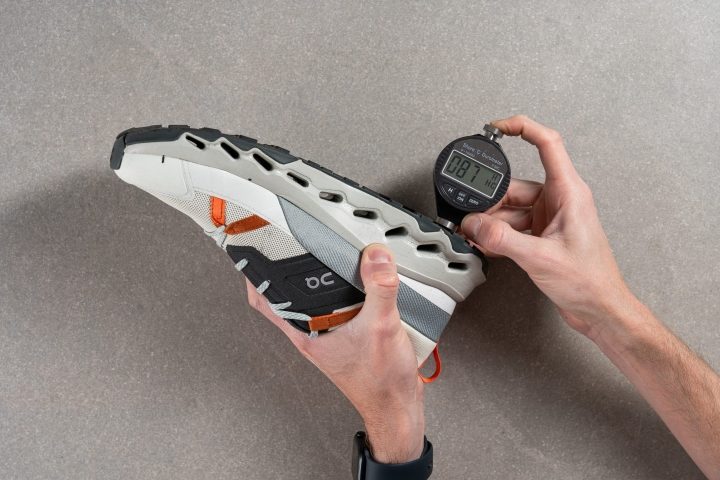
But luckily, the rubber itself happened to be rather sturdy with a high hardness reading of 87.0 HC. But is this enough to sustain regular abrasion on roads and trails?
| Cloudhorizon | 87.0 HC |
| Average | 84.5 HC |
Outsole durability
We used our trusty Dremel to find out.
With the speed set to 10K RPM, we ruthlessly drilled one of the shoe’s lugs for 22 seconds. Finally, the Cloudhorizon started to meet our durability expectations!
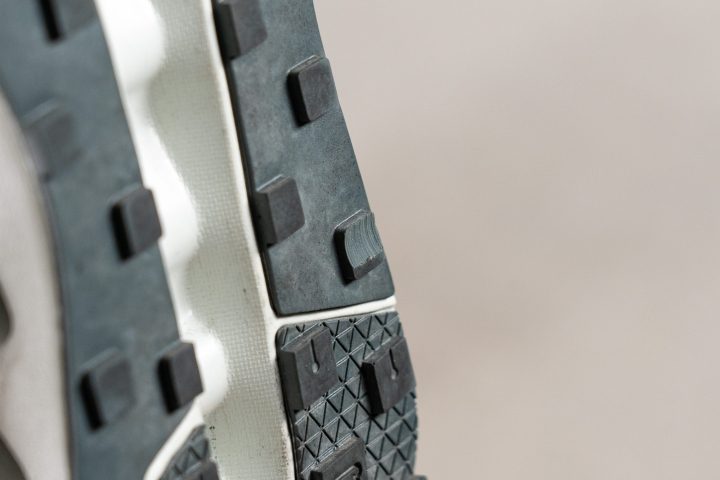
The damage on the shoe’s rubber was as shallow as 0.8 mm which is on par with the average of hiking shoes. But does it mean that the Cloudhorizon’s outsole will last as long as the average hiking shoe? Not necessarily.
| Cloudhorizon | 0.8 mm |
| Average | 1.0 mm |
Outsole thickness
That’s because the shoe’s outsole happens to be thinner than what we’ve come to expect from outdoor shoes.

At only 1.8 mm, it is one of the thinnest on our roster. Thus, we expect to see earlier signs of outsole wear on the Cloudhorizon compared to the more rugged hiking shoes.
| Cloudhorizon | 1.8 mm |
| Average | 2.6 mm |
Weight
So far, we haven't been very positively impressed by the Cloudhorizon. But don't worry, this On shoe has some pretty strong points to make. Specifically in the weight department...
It is by far THE lightest hiking shoe in our catalog!
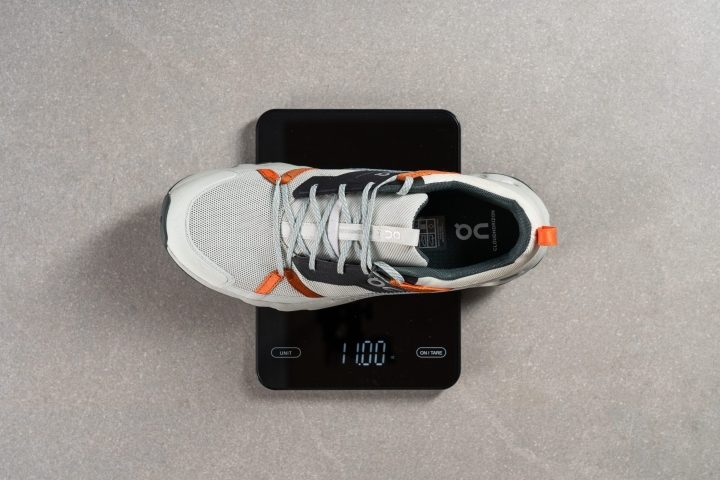
Showing as little as 11.0 oz (312g) on our scale, the Cloudhorizon undercuts other very light options like the Breathable for mild weather and the Salomon Outpulse (both at 11.6 oz/330g). It is also lighter than the industry average by over 2 oz!
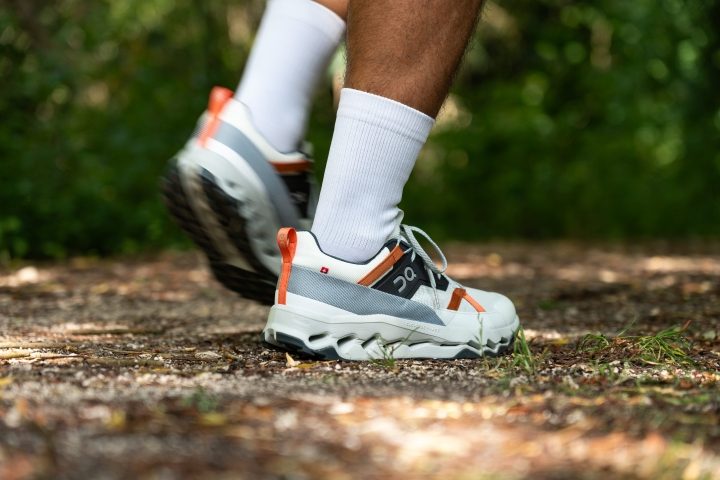
The Cloudhorizon feels (and looks) nothing like a typical hiking shoe. Think of it as a light casual sneaker that you can wear on a hiking date and then seamlessly transition back to the city streets or a coffee shop.
| Cloudhorizon | 11.01 oz (312g) |
| Average | 13.30 oz (377g) |
Cushioning
Heel stack
When the brand claims a shoe to be their most cushioned one, we cheerfully grab our caliper to check if that's true.

Measuring the heel stack of the Cloudhorizon, we are happy to confirm that statement. At 35.5 mm, it is about 4 mm thicker than the average and makes it to the max-cushioned range of hiking shoes. The trick is that the apertures of the shoe's Cloud-Tec Phase help to increase cushioning without actually adding more foam to the midsole.
The shoe's heel stack is nearly as tall as in the Hoka Anacapa Low GTX (36.0 mm) but is a bit lower than the Flat and square, we could barely even feel them on hard city streets (39.0 mm).
However, we can't complain about those few millimeters of difference because the Cloudhorizon never fell short of comfort or impact protection during our wear tests. We could confidently wear this shoe all day, even on concrete pavements. And on the trail, it provided a sufficient buffer to mute out sticks and stones.
| Cloudhorizon | 35.5 mm |
| Average | 31.1 mm |
Forefoot stack
But the shoe's abundant cushioning is not limited to the heel alone - its forefoot stack also surpasses the average by 5.5 mm!
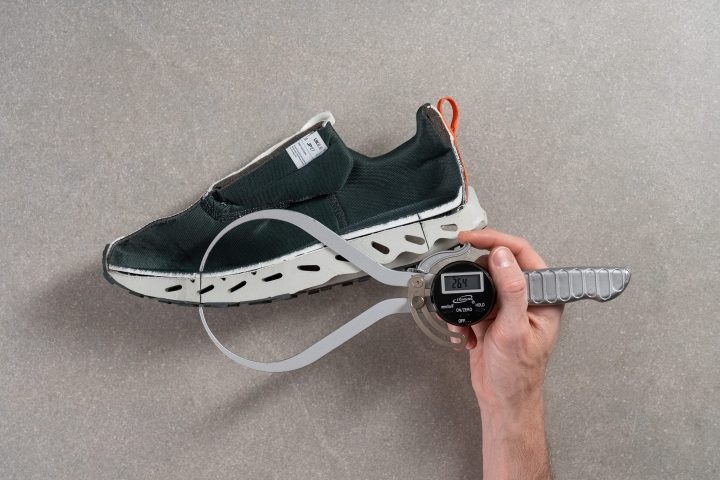
Having 26.4 mm of foam under the balls of our feet made us feel even more isolated from the ground.
Even the light cant shine through the padded lining inside the Cloudhorizon Hoka Anacapa Low GTX (25.5 mm) and is only second to the Flat and square, we could barely even feel them on hard city streets (31.0 mm). Looks like Hoka's attempt to offer the most cushioned hiking footwear faces some tough competition from On!
| Cloudhorizon | 26.4 mm |
| Average | 20.6 mm |
Drop
According to On's official specs, the Cloudhorizon should have a 6 mm heel-to-toe drop. Meaning that the heel should be elevated above the toes by 6 mm.

But based on our own stack measurements (following the rules set by World Athletics), Lateral stability test.
Even though we must point out such discrepancies in the measurements, in practice most wearers will not notice the difference. Unless you are an experienced trail runner coming from low-drop shoes or a barefoot shoe enthusiast.
A 9-mm drop is on par with the hiking shoe average and is ideal for people who need this shoe for casually hitting the trails. Your ankles and Achilles tendons are going to feel well-supported in this setup.
| Cloudhorizon | 9.1 mm |
| Average | 10.6 mm |
Midsole softness
The Cloudhorizon features the brand's unique cushioning tech in the form of compressible CloudTec Phase pods made of Heloin superfoam.

Sounds fancy but what does it mean?
It means a whole lot more shock absorption than most hiking shoes can provide! We also felt a nice touch of energy return which made the Cloudhorizon feel a bit more like a running shoe.
The Helion foam itself, however, is not plush. Measuring it with a Shore A durometer returned 26.3 HA which is a standard midsole softness for a hiking shoe.
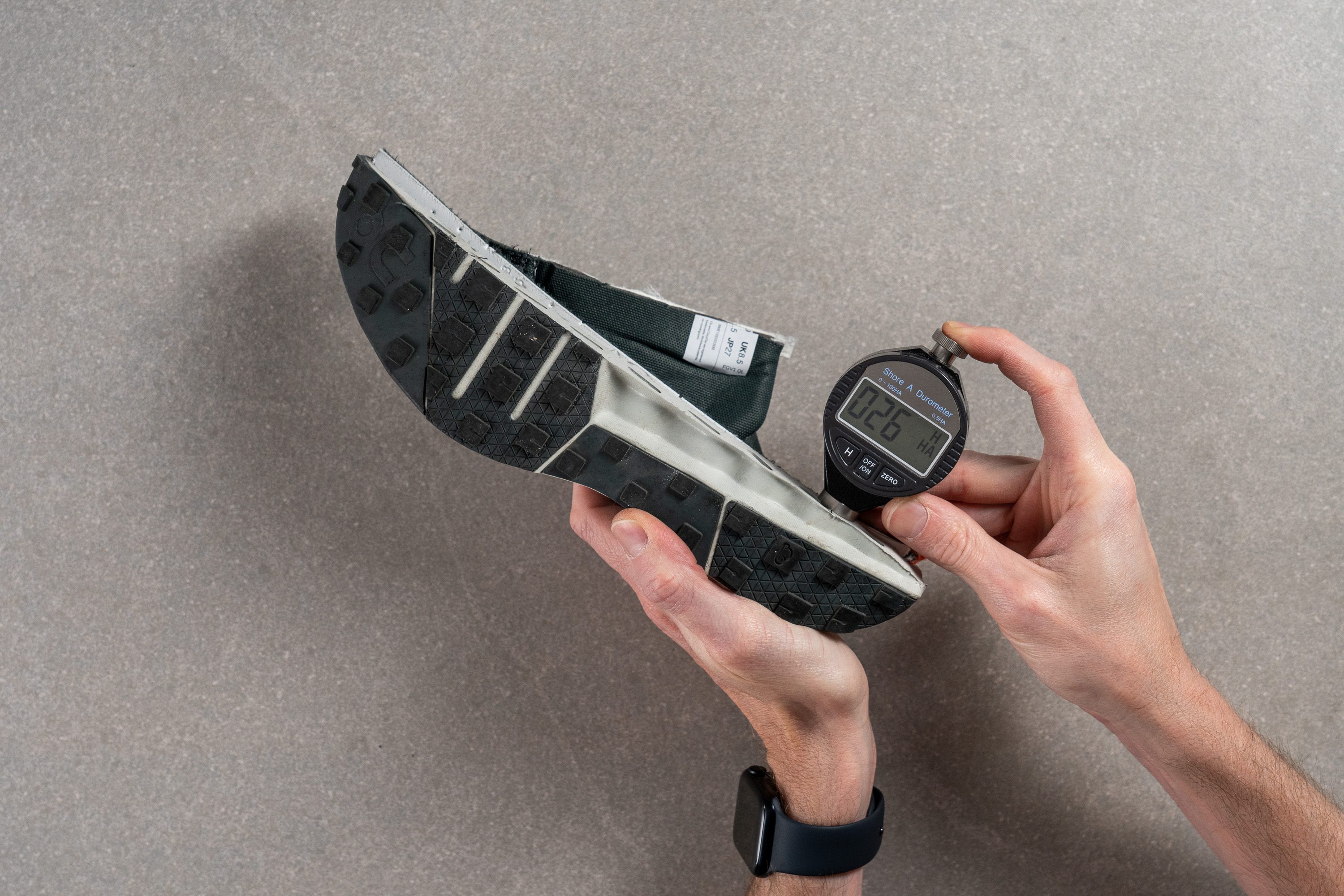
| Cloudhorizon | 26.3 HA |
| Average | 27.6 HA |
Difference in midsole softness in cold
Having tested the Helion foam in cold temperatures over and over again, we found that it shows minimal change on the durometer.
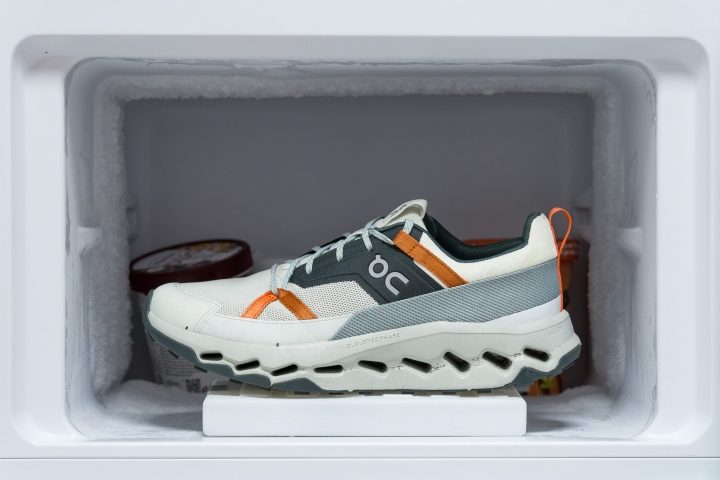
After keeping the Cloudhorizon in the freezer for 20 minutes, we repeated the measurement and found that the shoe's midsole softness indeed changed by only 11.4%.
| Cloudhorizon | 11.4% |
| Average | 17.6% |
Insole thickness
In addition to primary cushioning, the Cloudhorizon features a well-padded insole. It feels cozy underfoot and shows a standard insole thickness of 5.2 mm in the heel.
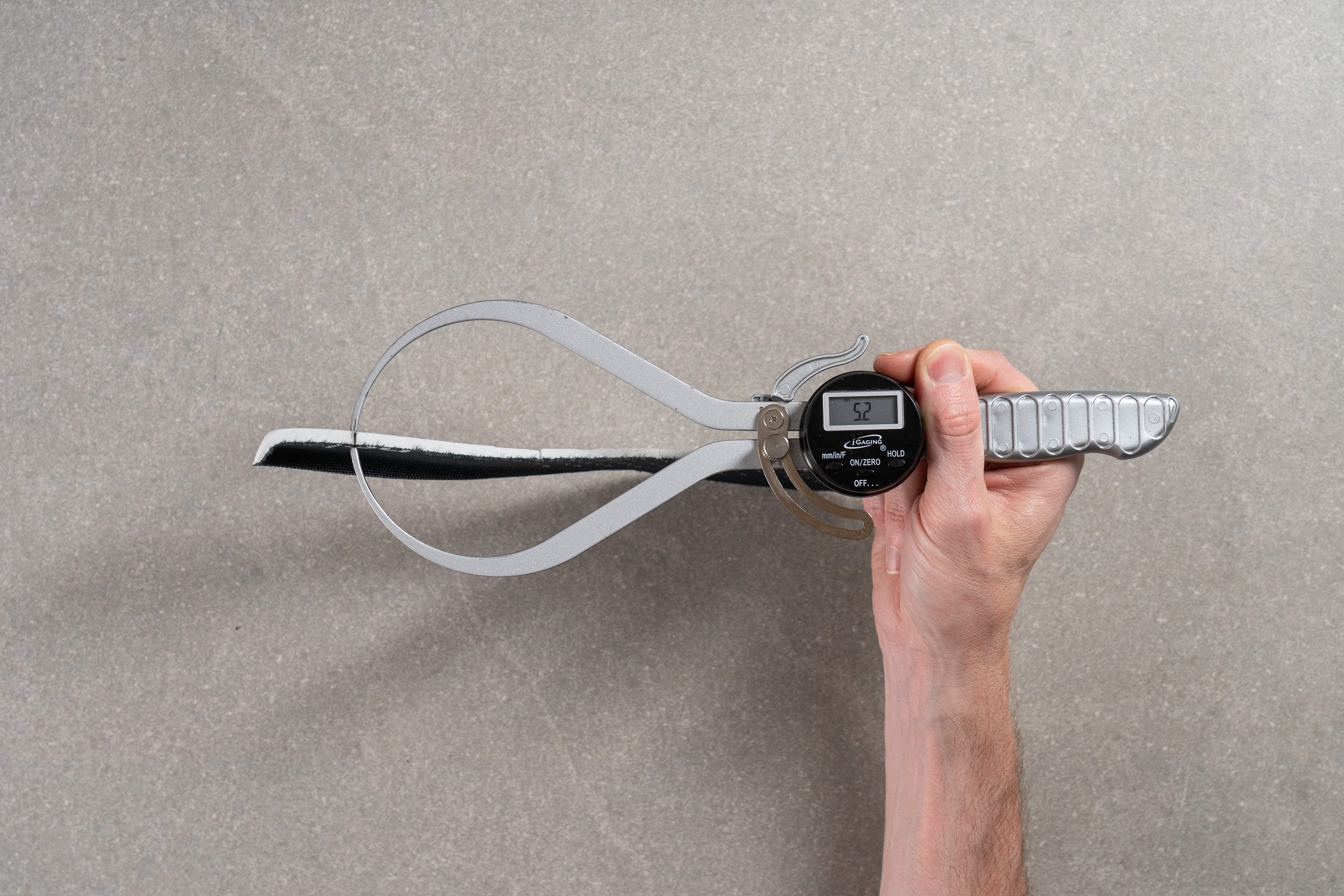
| Cloudhorizon | 5.2 mm |
| Average | 5.4 mm |
Stability
Lateral stability test
With its high stack, minimal reinforcements, and drain of proper arch support, the Cloudhorizon is not a shoe we would recommend for stability.
It doesn't mean that you will be twisting your ankles all over the place but we would warn people with overpronation, ankle instability, and similar foot conditions against choosing this On Cloud shoe. The Flat and square, we could barely even feel them on hard city streets is a much more reliable option for these folks.
Can you see the difference in lateral stability?
Torsional rigidity
The shoe's torsional rigidity tells us a lot about its stability. Designs that are easier to twist have fewer supportive elements in the midfoot which means less leverage to prevent the unfortunate ankle roll.
Checking the Cloudhorizon in our manual test, we didn't feel a lot of resistance from the shoe. It was a bit easier to bend than the average hiking shoe.
Heel padding durability.
We felt as though the Cloudhorizon had just enough firmness to avoid feeling unstable but not enough structure to make us 100% surefooted.
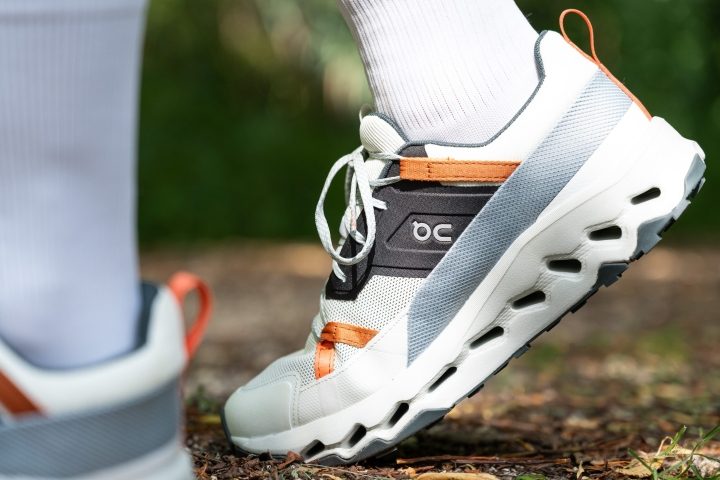
| Cloudhorizon | 3 |
| Average | 3.4 |
Heel counter stiffness
The shoe's heel counter is another example of that.
Giving it a push and squeeze in our manual test, we found that it had more give than the average hiking shoe heel. On a 1-5 stiffness scale, we gave it a middle-of-the-road score of 3.
It means that the Cloudhorizon will make you feel supported if:
- Midsole width in the heel
- you carry no backpack or it is a very light one
- But based on our own stack measurements following the
How we test.
| Cloudhorizon | 3 |
| Average | 3.6 |
you prioritize style in outdoor footwear even if it means less durability
Luckily, a few extra millimeters of midsole width earn the Cloudhorizon some bonus points in the stability department.
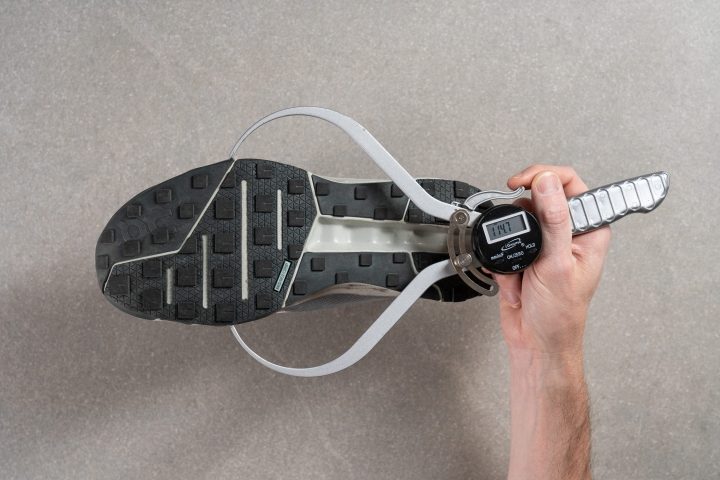
The shoe comes with a bit of an outrigger in the forefoot which shows 114.7 mm on our caliper. That's about 4 mm wider than the average hiking shoe forefoot.
| Cloudhorizon | 114.7 mm |
| Average | 110.1 mm |
Midsole width in the heel
We were also happy with the heel width of the Cloudhorizon. At 88.3 mm at the widest point, it is slightly wider than the average too.

| Cloudhorizon | 88.3 mm |
| Average | 86.7 mm |
Flexibility
Stiffness
The On Cloudhorizon is not particularly flexible but bends just enough to create smooth heel-to-toe transitions. Our force gauge test revealed that it takes 28.3N to bend the shoe to a 90-degree angle, which is the same as an average hiking shoe.
In addition, we found that the shoe's rockered shape also plays a key role in carrying the foot forward.
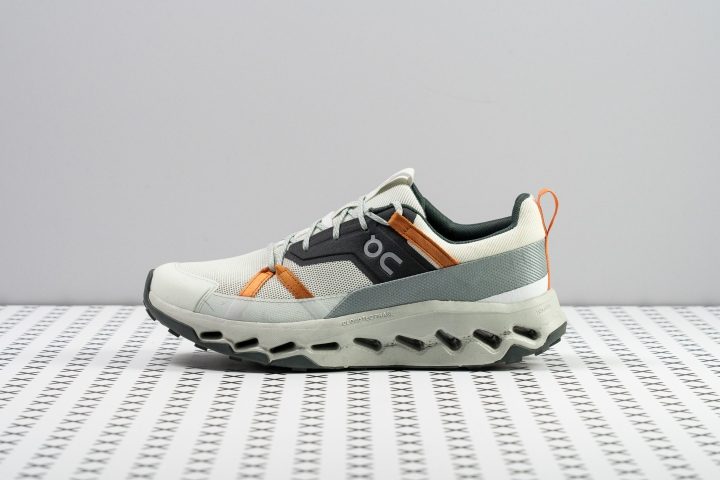
| Cloudhorizon | 28.3N |
| Average | 29.4N |
Transitions from city to trails seamlessly
Our freezer test revealed that the shoe stiffens only moderately in low temperatures.
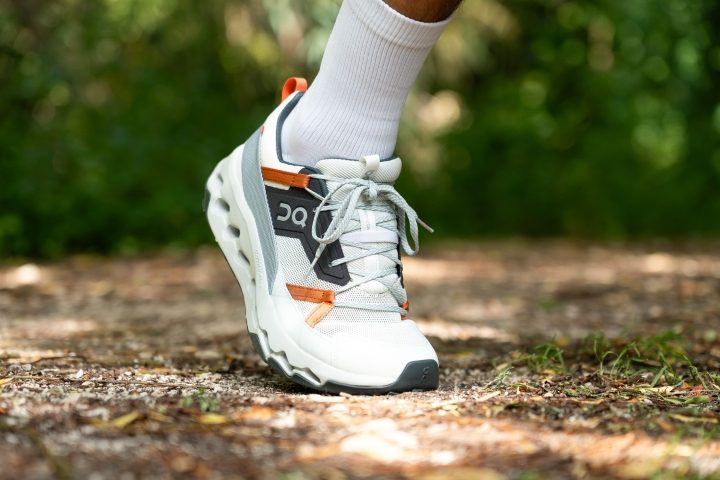
After a 20-minute exposure to low temperature, the Cloudhorizon needed 23.9% more force to bend to a 90-degree angle. This is not as much as the other hiking shoes required in the same conditions.
Considering the findings of both our freezer tests (midsole softness and stiffness), we can conclude that the Cloudhorizon remains quite comfortable in cold conditions.
| Cloudhorizon | 23.9% |
| Average | 29.9% |
Grip / Traction
Lug depth
The Cloudhorizon has some of the shallowest lugs we've seen on hiking shoes. While they work well for moderately rocky and rooty patches, these treads are helpless in soft and muddy terrain.
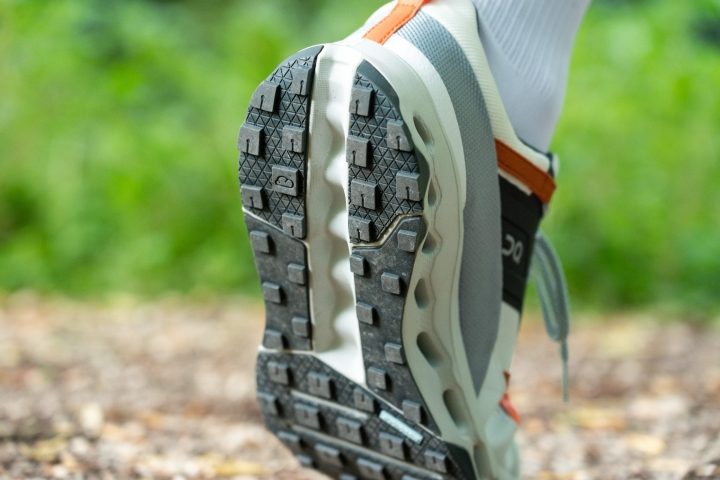
Flat and square, we could barely even feel them on hard city streets.
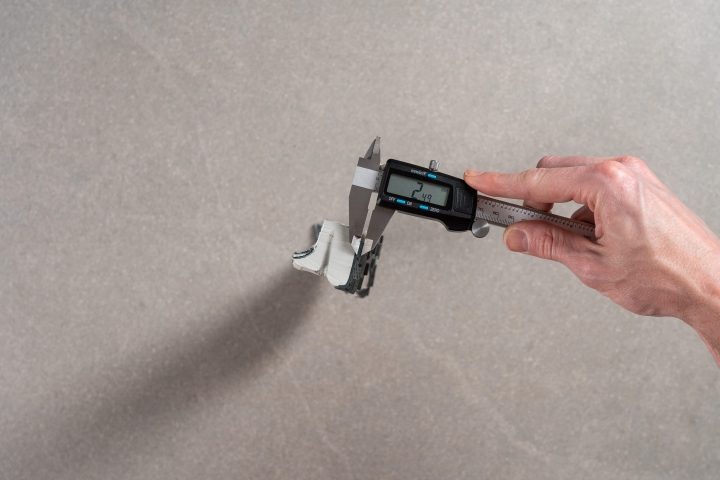
At only 2.5 mm they are not much deeper than the sneaker treads.

No, really, even the lugs on the New Balance 327 The shoes heel counter is another example of that!
| Cloudhorizon | 2.5 mm |
| Average | 3.9 mm |
Size and fit
Toebox width at the widest part
People with medium-width feet like ours are going to feel right at home in the Cloudhorizon. We found that the shoe's toebox fits just as expected for a D-medium width.
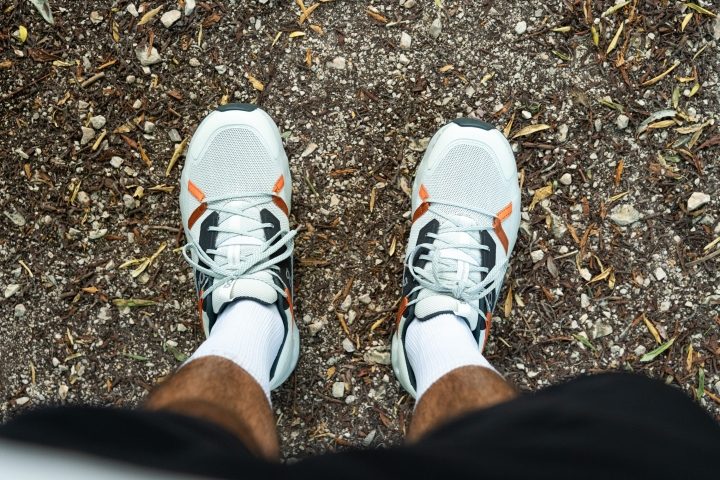
Measuring the widest part of the forefoot, we got 102.2 mm on the caliper. If falls into the medium range of toebox widths we've measured in our lab.

| Cloudhorizon | 102.2 mm |
| Average | 100.5 mm |
Toebox width at the big toe
We are also happy to report that the tip of the toebox is not very pointy in this shoe either. We got just a standard measurement of 81.1 mm in the big toe area.

We should also note that there is absolutely NO stretch in the shoe's upper so we wouldn't rely on a break-in period to help loosen the fit.
| Cloudhorizon | 81.1 mm |
| Average | 81.7 mm |
Tongue: gusset type
Featuring a semi-gusseted tongue, the On Cloudhorizon instantly elevates the fit and comfort of the shoe.

First, the gussets secure the tongue in place which prevents it from sliding sideways. Secondly, it helps the upper wrap around the foot more intimately creating a more foot-hugging sensation.
| Cloudhorizon | Both sides (semi) |
Comfort
Tongue padding
Measuring the shoe's tongue thickness with a caliper, we got 8.2 mm. We found it to be just right - neither too puffy nor too thin.

| Cloudhorizon | 8.2 mm |
| Average | 9.5 mm |
Heel tab
The shoe features two finger loops to help with the on-and-off action.
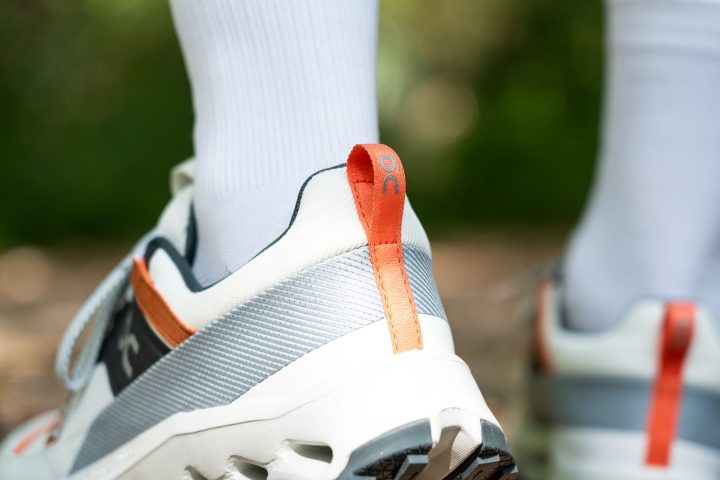
One is on the heel collar and the other one is on the tongue.
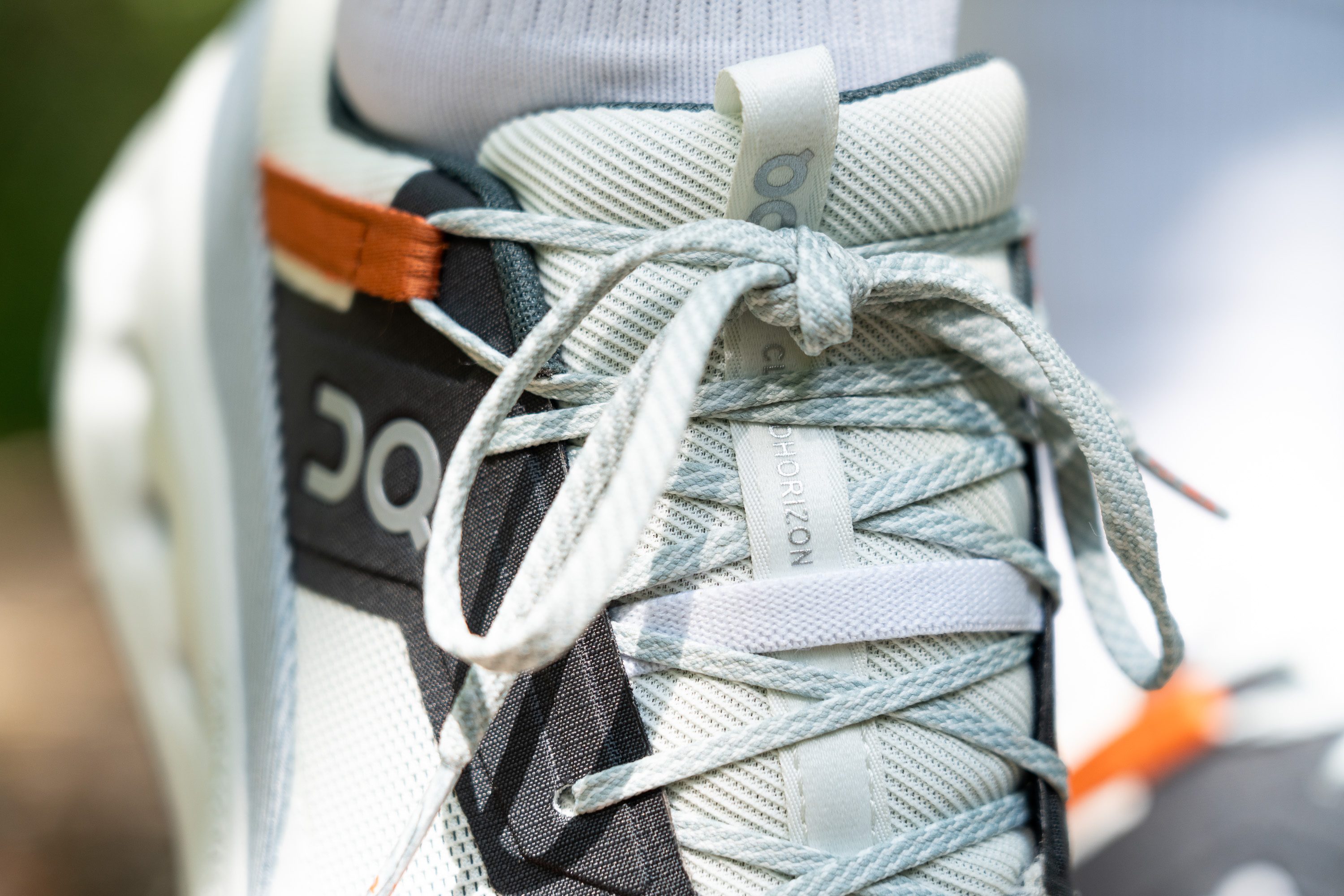
| Cloudhorizon | Finger loop |
Removable insole
Grip / Traction.
You can replace it with a custom orthotic but we had no gripes with the stock one. It is contoured to the foot and is even perforated for better aeration.
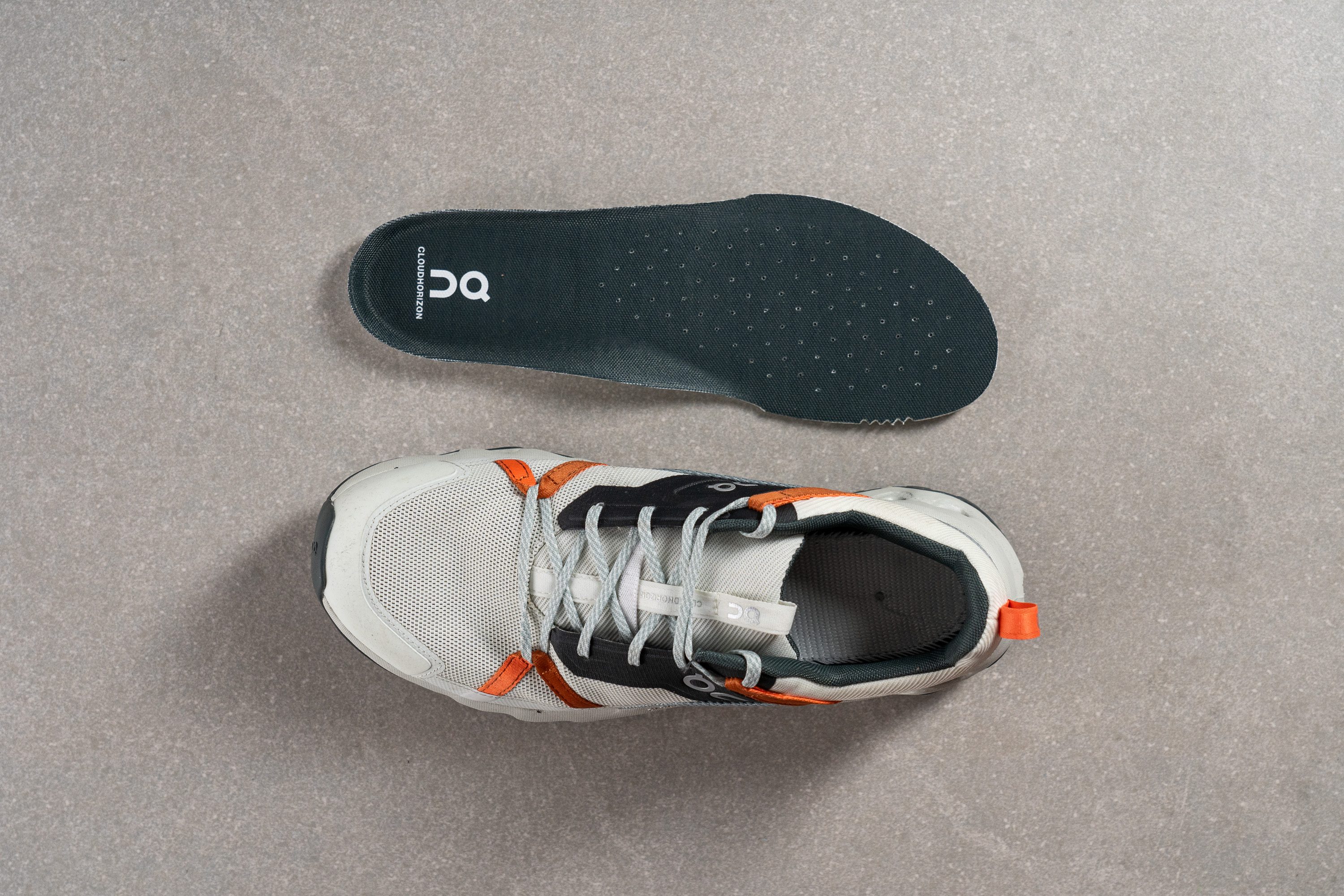
| Cloudhorizon | Yes |
Misc
Reflective elements
If your hike makes you lose track of time and you end up coming back i the dark, the reflective logo on the side of the shoe will keep you visible.
| Cloudhorizon | Yes |
Sustainable materials
As a welcome bonus, the Cloudhorizon's upper is made with about 88% recycled polyester. This might be a drop in the ocean but still better than no effort.
